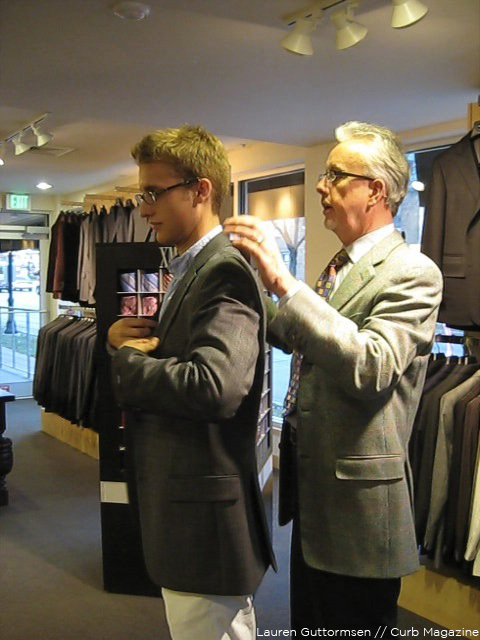Fabrics

“A good suit is a critical component for every successful man’s wardrobe,” says Tim Ryan, owner and president of Harley’s Store for Men in Shorewood.
Fabric choice inherently factors into the price of the garment, but also into whether you purchase a short-term outfit or a long-term investment. A favorite among designers and wearers alike, wool offers a classic finish and hardy durability.
However, pay attention to quality and blend when purchasing wool. The wrong blend can undermine the durability of the fabric, and while a heavier 200-thread count will keep you warm in winter, you’ll be king-of-the-pit-stains in summer.
Zegers recommends an all wool suit.
“There’s no synthetic in the fabric like in a poly-wool blend,” he says. “And wool keeps its shape better and doesn’t break down. It’s a little tougher fabric, so its going to last longer.”
Ask a salesman about thread-count and weight, and look for plain, dark colors for flexibility.
“You can’t go wrong with navy, charcoal or black,” Zegers says. “Those colors are very strong for just about every occasion.”
Cotton or linen, while perfectly wearable, do not make wise investments for your first or only suit. Nowhere near as durable or classic as wool, cotton suits also crease easily (but undoubtedly rock with the sleeves rolled up, a pink tee underneath and white loafers—Miami Vice-style). And linen, though great for warm weather fashion suits, wrinkles as soon as it leaves the hanger and may be inappropriate for some occasions.
If you will purchase many suits over your lifetime, fashionable cotton and linen suits offer opportunity for individuality and personal flair, but if you are new to suits or buying just one to last a long time, stick with wool.
Where to get it
When purchasing a suit, especially your first, go to the right place. A large department store will have adequate help and can afford to purchase in large amounts. But for a truly one-of-a-kind experience and individual attention, look local.
Smaller hometown stores have knowledgeable salesmen committed to helping you make the best decision, and owners and staff want to build long-term relationships, so they take care to make you comfortable and to establish a level of trust.
Buying a suit is a personal endeavor, so don’t worry about following trends or replicating that Tommy Hilfiger ad you saw. Find a store in line with your tastes and consult a salesman.
Wherever you decide to go, talk to someone who works there. You can’t aimlessly roam racks by yourself and expect a ‘Clooney-esque’ finishing look. Measuring and sizing are integral to the fit and overall look of the suit and require the expertise of an experienced salesman.
Many stores, like Zegers’, offer tailoring, but he emphasizes the importance of the initial fit. “Obviously, the less alterations you do, the better,” he says, “and that’s why people come here. We’re trying to get them the best possible fit right off the bat without [needing] a lot of alterations.”
Fit is everything
A proper fit is the most important part of purchasing a suit. One of the most common mistakes menswear specialists see, an ill-fitting suit, particularly a jacket that’s too big, which can ruin the whole appearance of the look.
While the baggy look may have qualified you for the cool crowd in high school, senior year is over. Most people notice your face and torso first, so if you’re swimming in a jacket that’s poorly fit—the shoulders sit too broad, the sleeves hang too long or the body appears too wide—you won’t look as refined as you should in such a classic garment.
“Suits aren’t an off-the-rack item,” Ryan says. “Most things need some sort of tailoring.” Most menswear stores offer complimentary tailoring or factor it into the price of the suit itself, so whether you think the suit needs alterations or not, ask a salesman about the correct fit and options for adjustments.
Craig Butenhoff, owner of Jazzman in Madison, says the most common tailoring work he does consists of taking in the body on jackets, and he insists it’s a necessary alteration for most.
Pages: 1 2 3 < Previous Next >




Discussion
No comments for “Suit Up!”